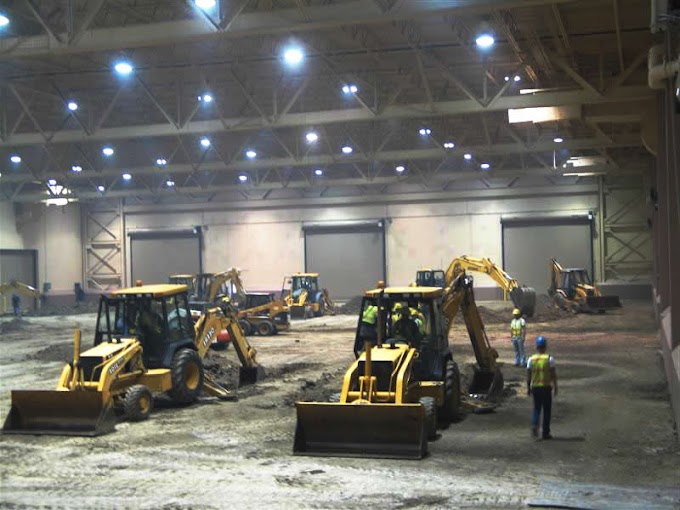 |
| Simple operation for operator must be know |
To operate a forklift there are requirements that must be known by 17 rules that must be met
Below are some simple rules to ensure the safe operation and use of the forklift truck. These tips are a guide to operating the forklift truck that incorporates the principles of health and safety when working on a forklift.
1. Operators must be qualified
Loading / unloading in the forklift must be performed by a trained, authorized person for the management and use of this equipment.
2. Charger work clothes loader
Combined protective work of the operator: helmet, safety shoes and a jacket with greater visibility (attention-grabbing).
Work clothing should not be taken from the details of the loader.
Do not press a button on the truck control panel when your hands are lubricated as they may slip and collide.
3. Inspection of the loader before starting work
The operator must inspect the forklift before use. It is necessary to check the errors: brake system, steering, control unit, signaling devices, mast and tires.
If defects or problems are detected, the vehicle must not be used. It is necessary to make repairs.
4. Start the charger
To enter the cabin, use the handrails and steps.
Before starting the truck, the operator must assume the correct position, all controls must be within reach, and the position of the operator's chair and mirror must be configured for the operator.
It is necessary to fasten the seatbelt;
If the operator is outside the workplace, the truck can not be switched on.
5. Correct operation
When managing a forklift, you must follow the basic rules and principles of operation in a particular area.
The operator may only use the truck in specially marked areas of the warehouse.
Do not exceed the specifications of the charger, in particular the maximum permissible load on the ground and the free height.
Consider the height of the load, the mast and the roof when leaving or entering the building.
Be careful when using the charger near the edge of the cargo bed or inclined surface to prevent it from tipping over.
Do not work on charging decks if they can not carry the weight of the charger with the charge.
6. Observe the speed limit
Never exceed the speed limits.
Reduce the speed in bends, otherwise you can tilt the forklift truck.
Do not brake suddenly.
Turn from one place to another to make sudden movements without problems.
7. To avoid danger
In order to avoid accidents and collisions, you should pay attention to areas with irregular surfaces or slippery surfaces.
Keep it away from foreign objects on the way of the charger, as a collision with the charger may lead to loss of control or loss of charge.
Use a beep as you approach corners, openings, sidewalks, etc. Warn pedestrians and other forklift drivers and avoid a collision.
When driving close to other forklifts, note the distance.
Enter a distance for the braking distance.
8. Avoid the dangers
Avoid knocks, holes, loose materials and be careful when the floor is slippery.
Do not drive with wooden parts scattered on the floor
This could cause the load to shift or lose control
Reduce the speed and use the horn near corners, exits, entrances, stairs, doors,
Pedestrian areas and people nearby
9. Securing the cargo space
The cargo before transport must not be damaged and secured
The load must be tilted on the fork on the side of the cab to increase stability.
Loading and unloading with a dangerous cargo is prohibited.
Make sure the load is correctly positioned on both forks.
If necessary, use ropes and cables to hold loads.
10. A good overview
If you can not see where you are going because of the fee, you can not go because the check must be free.
If the work is done in poor visibility conditions, you can use the help of a guide.
11. Loaders are only for the transportation of goods
Use the charger only for the transport of materials and goods.
People can not be used for transportation.
If you need to lift a person, use a fixed platform and follow the appropriate instructions.
12. Stay away from the mast
It is prohibited to stand or stand on the forks as the load may fall and cause injury.
Keep hands and feet away from cross sections
13. Movement on a sloped surface
Enter the sloping surface on the front and pull it down.
It is forbidden to load and unload on an inclined surface.
14. Make sure that the charger is not overloaded
Do not lift the load with the end of the fork.
Take into account the maximum charging capacity of the charger and never exceed it to avoid damage to the charger.
Overloading can cause the forklift to tip over.
15. Make sure that the load is evenly distributed
Lift or move the load only when it is in both forks.
Do not lift the load on a fork. Use platforms and rails that can carry the weight of the cargo.
Do not use damaged, deformed or broken pallets to close.
16. Forklift replenishment must take place in a special location.
Suspend the truck by switching off the ignition switch.
If the charger is not powered electrically, it should be refueled in a well-ventilated area away from naked flames or sparks.
17. When the change ends
After use, make sure that the truck is parked in a designated or authorized area.
Lower the forks completely to the ground and set the parking brake.
Turn off the forklift and remove the key.
Do not leave a forklift unattended.



0 Comments